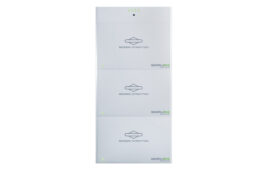International solar mounting system manufacturer Schletter Group will exhibit its ground- and roof-mounted PV racking systems at RE+, the United States’ most-attended solar trade show, in Las Vegas from September 12 to 14.
“We have consistently developed our product portfolio with new geometries and high-quality steel,” said Adrian Noronho, CEO of Schletter North America. “As a result, we have significantly improved the ratio between material input and installed PV power. Thus, our systems among the international leaders in terms of power-to-weight ratio. In addition, Schletter systems are designed to function for 30 years under the harshest conditions, resulting in extremely high cost-efficiency.”
Credit: Schletter Group
Schletter will have its Tracking System 1P, a one-in-portrait single-axis solar tracker designed for use with large format modules at the show. It can accommodate bifacial modules with a height of up to 8.2 ft (250 cm). The Tracking System 1P weighs less than 66 lbs (30 kg) per kW, which is approximately 30% lighter than comparable products on the market, according to a press release.
“This lighter weight not only reduces transportation and logistics costs, but also makes on-site installation much easier,” said Cedrik Zapfe, CTO of Schletter.
The Tracking System 1P shares a similar design as Schletter’s Tracking System 2P. The heart of the system is the patented mechanical self-locking Geneva drive: this gear system is used to rotate the arch at each post so that the structure is locked in place at any tilt angle, giving it the structural characteristics of a fixed tilt system. This eliminates wind-induced vibrations that can lead to resonance (also known as the galloping effect) without the need for dampers or other auxiliary solutions. The Schletter Tracking System in the stowed position can withstand wind speeds of up to 160 mph.
Schletter will also present fixed-tilt racking at RE+, including the latest generation FS Uno single-post system. Compared to the previous version, the system requires less material per kilowatt of power and has a higher load capacity. This is made possible by using girders and purlins made of high-performance steel and a new geometry that is now an open-bottom isosceles trapezoid instead of a Z-shape, creating a higher load-bearing capacity, allowing spans of up to 19.6 ft (6.5 m).
“Our ground-mounted system FS Uno is primarily aimed at yield optimization,” Zapfe said. “It’s about installing the maximum PV power on as few posts as possible without any static disadvantages.”
The company’s other ground-mounted system is PVMax S. The two-post steel system with a ballast concrete foundation is particularly suitable for areas where pile driving is uneconomical or not feasible due to corrosive soil conditions.
Schletter will present its updated flat roof system. The ballasted racking can be adjusted to support different tilt angles, module sizes or orientations.
“Our wind tunnel tests have shown that it is aerodynamically much more advantageous to place the maintenance aisle between the upper edges of the elevated modules and not, as before, at the lower edges,” Zapfe said. “In this way, up to 10% of the ballast can be saved. This allows developers to maintain the necessary static reserves, even if the roof has limited residual load-bearing capacity.”
All of this solar racking will be on display at booth 21070 at RE+.
News item from The Schletter Group





Tell Us What You Think!